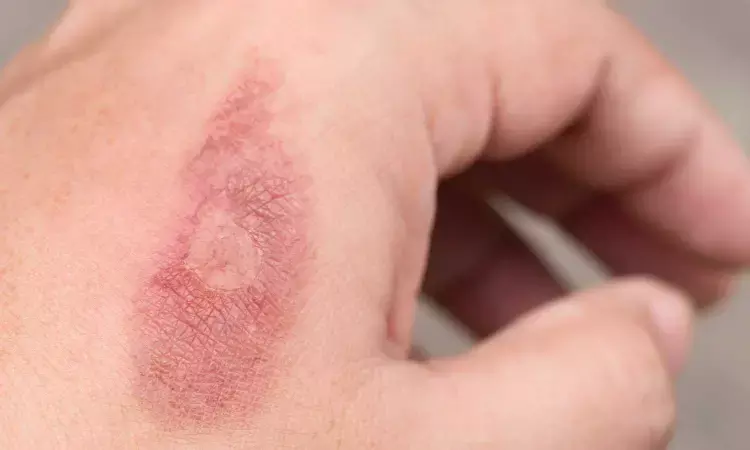- Home
- Medical news & Guidelines
- Anesthesiology
- Cardiology and CTVS
- Critical Care
- Dentistry
- Dermatology
- Diabetes and Endocrinology
- ENT
- Gastroenterology
- Medicine
- Nephrology
- Neurology
- Obstretics-Gynaecology
- Oncology
- Ophthalmology
- Orthopaedics
- Pediatrics-Neonatology
- Psychiatry
- Pulmonology
- Radiology
- Surgery
- Urology
- Laboratory Medicine
- Diet
- Nursing
- Paramedical
- Physiotherapy
- Health news
- Fact Check
- Bone Health Fact Check
- Brain Health Fact Check
- Cancer Related Fact Check
- Child Care Fact Check
- Dental and oral health fact check
- Diabetes and metabolic health fact check
- Diet and Nutrition Fact Check
- Eye and ENT Care Fact Check
- Fitness fact check
- Gut health fact check
- Heart health fact check
- Kidney health fact check
- Medical education fact check
- Men's health fact check
- Respiratory fact check
- Skin and hair care fact check
- Vaccine and Immunization fact check
- Women's health fact check
- AYUSH
- State News
- Andaman and Nicobar Islands
- Andhra Pradesh
- Arunachal Pradesh
- Assam
- Bihar
- Chandigarh
- Chattisgarh
- Dadra and Nagar Haveli
- Daman and Diu
- Delhi
- Goa
- Gujarat
- Haryana
- Himachal Pradesh
- Jammu & Kashmir
- Jharkhand
- Karnataka
- Kerala
- Ladakh
- Lakshadweep
- Madhya Pradesh
- Maharashtra
- Manipur
- Meghalaya
- Mizoram
- Nagaland
- Odisha
- Puducherry
- Punjab
- Rajasthan
- Sikkim
- Tamil Nadu
- Telangana
- Tripura
- Uttar Pradesh
- Uttrakhand
- West Bengal
- Medical Education
- Industry
Younger age, prolonged Healing Time, and Burn Location tied to Poorer Long-Term Scar Outcomes in Children: Study

A new study published in the journal of Nature Scientific Reports revealed that among pediatric burn patients, worse long-term scar outcomes—measured by POSAS scores—were associated with younger age at injury, prolonged postoperative healing time, and burns located on the trunk or lower extremities.
Larger, deeper burns, injuries sustained at a younger age, burns in skin types with pigmentation, and a longer recovery period following an accident are all linked to worse scar results. These variables specifically enhance the risk of hypertrophic scarring. Although research on scar quality in children who have had burns has been conducted, there is a dearth of long-term results monitoring.
There is currently no clear international agreement about the best time to do surgery for children who have partial-thickness burns. It might be challenging to choose between debridement as soon as possible (before 72 hours) and debridement after the burn has completely healed (within 1-3 weeks). A crucial stage in this procedure is doing an accurate clinical examination to ascertain the extent of the burn. Therefore, this study examined how patients and therapy characteristics affected the quality of scars in pediatric burn patients one year following skin transplantation.
Age, skin type, and burn location with patient characteristics, surgical kind, timing, and recovery periods were therapy factors. The study included pediatric patients (less than 18 years old) who presented to a National Burn Unit between 2011 and 2020. Those who needed skin grafting as their primary burn treatment and had burn damage ranging from 1% to 14.9% total body surface area (TBSA) were included. Patients were not included if they did not show up for their follow-up appointment after 12 months. A modified version of the Patient and Observer Scar Assessment Scale, version 2.0 (POSAS), was used to evaluate standardized clinical photos.
There were thirty kids (median age: 3.9 years). Younger age at injury time (p < 0.001), body location of the trunk (p < 0.002), or lower extremities (p < 0.001), and a longer healing period following skin grafting were factors that independently contributed to higher (worse) POSAS ratings.
For POSAS scores, the interval between the injury and surgery was not an independent factor.
This research lacked the statistics necessary to distinguish between meshed and non-meshed graft types based on variations in scar quality.
Overall, in this study, researchers discovered that children who had burns at a younger age, had burns on the trunk or lower extremities, or had a longer recovery period following skin grafting had poorer long-term scar results.
Source:
Steinvall, I., Kennedy, S., Karlsson, M., Ellabban, M. A., Sjöberg, F., Andersson, C., Elmasry, M., & Abdelrahman, I. (2025). Evaluating scar outcomes in pediatric burn patients following skin grafting. Scientific Reports, 15(1), 20205. https://doi.org/10.1038/s41598-025-06378-y
Neuroscience Masters graduate
Jacinthlyn Sylvia, a Neuroscience Master's graduate from Chennai has worked extensively in deciphering the neurobiology of cognition and motor control in aging. She also has spread-out exposure to Neurosurgery from her Bachelor’s. She is currently involved in active Neuro-Oncology research. She is an upcoming neuroscientist with a fiery passion for writing. Her news cover at Medical Dialogues feature recent discoveries and updates from the healthcare and biomedical research fields. She can be reached at editorial@medicaldialogues.in
Dr Kamal Kant Kohli-MBBS, DTCD- a chest specialist with more than 30 years of practice and a flair for writing clinical articles, Dr Kamal Kant Kohli joined Medical Dialogues as a Chief Editor of Medical News. Besides writing articles, as an editor, he proofreads and verifies all the medical content published on Medical Dialogues including those coming from journals, studies,medical conferences,guidelines etc. Email: drkohli@medicaldialogues.in. Contact no. 011-43720751


